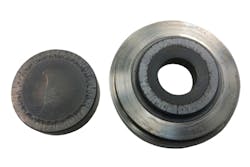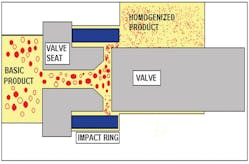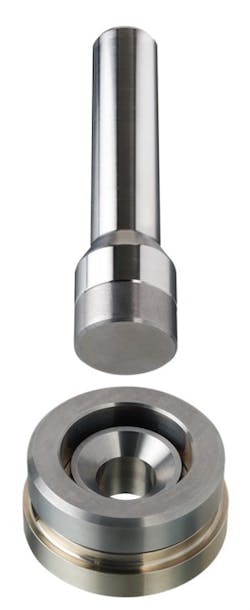Homogenizers are widely used across many industries including food, beverage, pharmaceutical, biotechnology and chemical. The processes they operate in have a huge variety of conditions and may require consideration for sterile conditions, abrasive fluids, a wide range of fluid viscosities, high pressures or high flow rates. What can be done to ensure the best is obtained from a homogenization process for a specific application, and how can that performance be maintained through the lifetime of the machine?
The homogenization process is designed to give an even distribution of components within a fluid. This may be to improve texture, stability, properties of the fluid (e.g. to obtain better fuel combustion), clinical effectiveness (better active ingredient dispersion in pharmaceuticals) or to disrupt cells in biotech processes without chemicals or solvents. Although the principles of operation of a homogenizer are pretty much the same across different models, selecting the correct materials, geometry and configuration are vital to the machine’s performance. Once operational, understanding how to maintain optimal performance of the homogenizer is also key to ensuring smooth operation and high-quality process results throughout its lifetime.
Homogenizing valves
At the heart of a homogenizer is the homogenizing valve. The homogenization process works by forcing the basic product within the process through a small area between the valve and seat at high pressure. This creates a rapid increase in the velocity of the product and a decrease in the pressure. The subsequent turbulence and pressure differences this generates tears particles within the fluid apart. While multiple passes through a homogenizer can produce narrower particle size distribution within the fluid, many different valve and material configurations are available to best suit the characteristics of the process fluid. Understanding the products involved, their compositions, structures and abrasiveness ensures correct selection of the required type of homogenization valve.
Figure 1. Schematic homogenizing valve arrangement
Why materials & geometries are vital
Valves, including valve seats, are designed for specific applications by configuring several factors such as geometry and material of construction. In terms of geometry, the radial distance through which the fluid travels in the homogenizing valve/seat gap (land) is critical.
By putting a large inner chamfer on the flat valve, a short-land valve seat is produced. The “land” is the surface on the seat that the fluid passes over as it travels through the gap between the valve and the seat. The short-land valve is beneficial when processing emulsions with the lowest homogenizing pressure possible to achieve normal shelf stability. This valve usually requires a second-stage valve or a back-pressure device.
The overall goal in valve design is to provide the best homogenizing effect for the least energy consumption while providing the longest service life. Through experimental tests and experience, it has been found that certain valve geometries are more efficient at homogenization than others, depending on the product or process involved.
Certain applications are specified with a two-stage homogenizing arrangement. In such cases, the valve type and material for the second stage are also carefully matched to the requirements.
Low-pressure applications
Operating under 250 Bar (3,600 psi), low-pressure homogenization tends to use valves in stellite alloy or tungsten carbide material. The fluids typically do not contain abrasive particles, for example, wax and grease emulsions.
Medium-pressure applications
Many fluids are homogenized in the 250 to 600 Bar (3,600 to 8,700 psi) pressure range and will often contain abrasive particles; Examples include silicone suspensions, carbon black and various emulsions. The valves for such applications are generally available in materials such as stellite alloy, tungsten carbide or ceramic. Tungsten carbide is selected for more abrasive fluids because of its hard-wearing characteristics.
Image 2. A single-stage or two-stage homogenization valve for all products
High-pressure homogenizing
These applications operate at pressures above 600 Bar (8,700 psi) and include cellulose fiber suspension, titanium dioxide suspension, bacteria cell disruption and algae cell disruption. The standard material is ceramic though stellite alloy and tungsten carbide are available as alternatives. Tungsten carbide is more hard-wearing than ceramic in many applications; However, ceramic is preferred at higher operating pressure drops.
Maintain to optimize
For a given pressure and flow of a single emulsion, the user should expect consistent results from the homogenizer. By its nature, however, the homogenizing valve is a wear part and requires good, predictive maintenance strategies to ensure maximum run times without unscheduled downtimes. The environment within which the valve sits is also important to its operation, so correct maintenance of the complete homogenizer is needed to optimize its reliability and maintain its performance.
Save time & money
The following are some top tips and tricks that may help keep a homogenizer performing at its best:
- Always protect the homogenizer from the possibility that foreign bodies/particles could enter the machine.
- Introduce preventative maintenance for the homogenizer wear parts, especially the homogenizing valve parts.
- Conduct regular inspection of the condition of valve, seats and impact rings following the manufacturers’ recommendations.
- In many cases, it is possible to regrind the valve seat to restore optimal performance.
- Where the valves and seats are worn, they should be replaced immediately. Image 1 shows continuous radial wear marks, which will give a poor homogenizing result.
- When testing new formulations or recipes, always check that the homogenizer is designed for the flow, pressure and level of particles.
Summary
The art of producing efficient, reliable and consistent homogenization results is based on an in-depth understanding of emulsions and production goals, whatever the application.
Anders Kold is global product sales manager, homogenizers; Con O-Driscoll is global product manager, dispersion products; and Leif S. Larsen is developing engineer, homogenizers, for SPX FLOW Technology. Based in Charlotte, North Carolina, SPX FLOW supplies highly engineered flow components, process equipment and turnkey systems along with the related aftermarket parts and services, for the food and beverage, power and energy, and industrial end markets. To learn more about SPX FLOW, visit spxflow.com.





